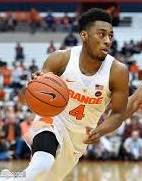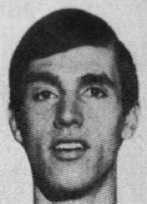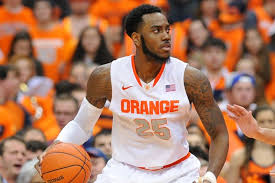Syracuse University has had its share of great players, though the Orangemen are probably more noted for the great point guards and forwards they have had. The Orangemen have had a few great centers along the way. Arinze Onuaku, who finished his career this past season, is clearly one of the top Syracuse centers ever. But how good was he in comparison? Who was the best?
That is a tough question, for a variety of reasons. The center position has changed more than any other position over the history of the game. In the early 1900s the center was the primary focal point of the offense. He did a majority of the ball handling and playmaking, along with often being the primary scorer. Centers in this era were often the best athlete on the court, and were about 5’11 to 6’2”.
In the late 1920s the game was evolving so that ‘big men’, players at 6’3”, were in the center position. This was a necessity as there was a jump ball after every made basket in the game. By the early 1930s there were teams who had centers whose primary purpose was to win the jump ball. Syracuse’s coach
Lew Andreas, was a leading proponent of eliminating the jump ball after each basket, exactly for that reason, and by 1936 they had successfully eliminate that rule.
Height was still becoming a factor for centers, but the arrival of
George Mikan in the 1940s, showed the dominance of a truly talented big man, and then the emergence of giants
Wilt Chamberlain and
Bill Russell in the 1950s, changed the center position forever. Russell introduced the concept of an absolute dominating defensive force, while Chamberlain brought the unstoppable offensive machine.
The center position probably has more players than any other position that has young men with very raw, if limited skills as freshman, who develop into outstanding players by their senior year. This is due to a combination of the tall centers having to wait for their bodies to catch up to their height, as well as finding it significantly different to be a giant among teens in high school, to being a giant among peers in college. So when you evaluate the greatness of a center at college, are you evaluating how he performed over his entire career, or how he performed his last year?
I am going to evaluate centers in the context of today’s center, with all due apologies to the disservice to
Joe Schwarzer and
Lew Castle, two outstanding All-Americans, who were clearly the best all around basketball players on their teams. Today they would have been great guards; and their style of play even in their era would have been more similar to today’s guard than center.
I am going to ignore forwards such as Derrick Coleman, Marty Byrnes and Chuck Richards, who each played center for a season out of necessity, but are far more remembered for their outstanding forward play.
So who is in my top 10? My apologies to the following fine centers who did not make that list: Andre Hawkins, Mookie Watkins, Conrad McRae, Royce Newell, and LeRon Ellis.
Ed Sonderman was the first true athletic big center at Syracuse. He was 6’6”, weighed about 210 lbs, and played from 1935-1937. He was a strong offensive force, and is considered the top Syracuse big man of the first half century. But Sonderman did not make the top 10.
At #10 is
Ed Miller (1950-1952). Miller came to Syracuse as a very awkward moving 6’8” teen, and he improved steadily over his three years on varsity. Miller would be second in scoring on the team his first two years, and lead the team in scoring his senior year. He helped Syracuse get to the NIT tournament in 1950 (very prestigious at the time), and win the National College Championship Tournament in 1951. Miller would be the first Syracuse player ever to
score 40 points in a game.
#9 is
Jon Cincebox (1957-1959). Cincebox was an outstanding rebounder in his era, averaging 14.6 rebounds a game, and setting the school record for total rebounds, that would not be broken for 30 years until Coleman came along. Cincebox sported a crew cut, was a master of the hook shot, and helped Syracuse to the Elite Eight his sophomore season.
At #8 is
Otis Hill (1994-1997). Hill was a burly center who played a rugged inside game and was foul prone his entire career. As a freshman his offensive repertoire consisted of a dunk shot. His junior season, his strong play in the middle was helpful in Syracuse reaching the Final Four, and he was second in the team in scoring behind John Wallace, even though he played only 24 minutes a game. By his senior year he had developed a nice 10 foot jump shot, and was one of the primary offensive weapons on the team.
#7 is one Dave Bing’s teammates, Rick Dean (1965-1967). Otis Hill’s style was considered reminiscent of Dean, who has played 30 years earlier. Dean was 6’6”, 230 lbs, but could still run the court in Syracuse’s up style offense of the 1960s. Dean had a nice 10 foot jumper, was a very good free throw shooter (he shot 81% his junior season, and 76% his senior). Dean would average 18 ppg and 9 rebounds his senior year.
#6 is
Arinze Onuaku (2006-2010). Onuaku was huge man in the middle at 6’9”, 255 lbs, and he sported a very muscular body. Onuaku played the middle of the zone defense extremely effectively; he was not a shot blocker, but was outstanding at maintaining his position, and keeping offensive players away from the hoop. He had a severe knee injury his sophomore season, and while he would rehabilitate the knee, he would continue to have leg issues in his career that limited his playing time. Offensively, Onuaku knew his limits, and stayed within his range, never more than 5 feet from the hoop. He was extremely effective in that short range, particularly with his hook shot, and is the most accurate shooter in Syracuse history at 64.8%. The two big knocks on Onuaku was that he was the worst free throw shooter in Syracuse history (by far), and he did not always hustle back down the court defensively.
#5 is
Bill Smith (1969-1971). Smith was a tempormental giant at 6’11”, who was an outstanding rebounder and scorer (12.9 rpg, 20.7 ppg). He possessed a nice 10 foot jump shot, and was extremely effective near the hoop (59.6%). He holds the Syracuse single game scoring record with
47 points, against Lafayette. I’d rate Smith higher except that the level of competition for Syracuse in his era was less than today’s, and Syracuse was 9-16 and 12-12 his first two seasons.
#4 is
Danny Schayes (1978-1981). Schayes was a very good college center who had the unfortunate situation of being a year behind Roosevelt Bouie. Coach Jim Boeheim tried Schayes at forward, in an effort to get him playing time earlier in his career, but it was not a position well suited for Schayes. He was probably the most fundamentally sound big man in Syracuse history. A decent ball handler, with excellent passing skills, outstanding free throw shooting (80.6% for his career), and solid from the floor (55.4%).
#3 is
Etan Thomas (1997-2000). Thomas was probably the best defensive center in Syracuse history. He was a great shot blocker, and was named the Big East Defensive player of the year twice. He developed into a solid inside scorer, making 60% of his shots. He was a solid, but not great rebounder. Thomas was also a solid ball handler, not prone to turnovers, and finished his career as Syracuse’s all time shot blocker with 424 blocked shots.
The #1 and #2 picks are very tough. The candidates are Roosevelt Bouie and Rony Seikaly, and this gets back to how do you want to evaluate them. Bouie was much better over four years, Seikaly much better his senior year.
Ultimately, I go with Bouie as #2. If Etan Thomas was not the best defensive center at Syracuse,
Roosevelt Bouie surely was. Part of the famous Louie N’ Bouie show, Bouie was a star his freshman year. He was a tremendous shot blocker, and could run the court well, which made him well suited for Syracuse’s fast break offense. Bouie made a high percentage of his field goal shots (he held the record until Onuaku broke it this year), and he was a very good rebounder. When he graduated from Syracuse he was the #2 all time scorer for Syracuse (long since surpassed). Bouie and Louis Orr brought the Syracuse basketball program to National attention and to initial prominence in the Big East.
#1 goes to
Rony Seikaly. Seikaly came to Syracuse as a novice to basketball, having only recently learned the game after playing years of soccer in Greece. He would redshirt one year, and even in his freshman year he was overweight, and had only one shot, a tomahawk dunk, that he did not always make. He was extremely foul prone, fouling out of 1/3 of his games. But he improved over the years. He worked himself into great shape, learned to run up and down the court on both offensive and defense, and became a terrific shot blocker. His junior season, he started to play consistently with intensity and passion, and led Syracuse to the National Championship game against Indiana. Seikaly would develop a nice 10-15 foot jump shot his senior year, and would be a dominating offense force most of the season, despite sharing the ball with Stephen Thompson, Coleman and Sherman Douglas.











